Researching Social Isolation: Methodology for Student Studies
VerifiedAdded on 2022/08/12
|13
|3362
|32
Report
AI Summary
This report outlines the research methodology employed to investigate the relationship between social isolation and loneliness among students with visual impairments in third-level education in Ireland. The research adopts an exploratory approach, utilizing basic research principles and a cross-sectional research design. Qualitative data is gathered through ethnographic methods, specifically semi-structured interviews, from a purposive sample of 10 participants. The study considers ontological philosophical considerations, acknowledging both the strengths and limitations inherent in the chosen methods. This research aims to contribute to a deeper understanding of the challenges faced by visually impaired students and inform future interventions.

Research
2/18/2020
2/18/2020
Paraphrase This Document
Need a fresh take? Get an instant paraphrase of this document with our AI Paraphraser
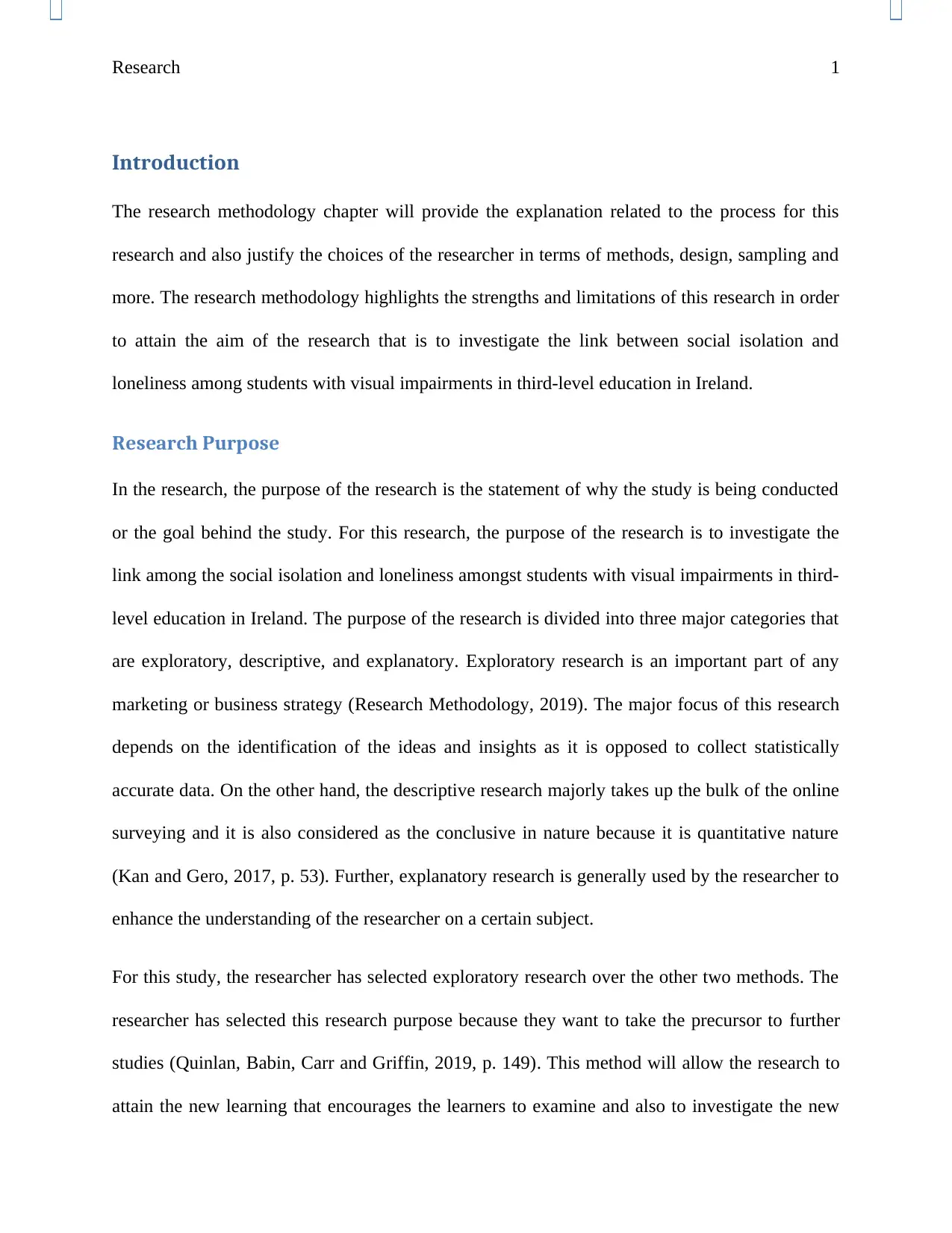
Research 1
Introduction
The research methodology chapter will provide the explanation related to the process for this
research and also justify the choices of the researcher in terms of methods, design, sampling and
more. The research methodology highlights the strengths and limitations of this research in order
to attain the aim of the research that is to investigate the link between social isolation and
loneliness among students with visual impairments in third-level education in Ireland.
Research Purpose
In the research, the purpose of the research is the statement of why the study is being conducted
or the goal behind the study. For this research, the purpose of the research is to investigate the
link among the social isolation and loneliness amongst students with visual impairments in third-
level education in Ireland. The purpose of the research is divided into three major categories that
are exploratory, descriptive, and explanatory. Exploratory research is an important part of any
marketing or business strategy (Research Methodology, 2019). The major focus of this research
depends on the identification of the ideas and insights as it is opposed to collect statistically
accurate data. On the other hand, the descriptive research majorly takes up the bulk of the online
surveying and it is also considered as the conclusive in nature because it is quantitative nature
(Kan and Gero, 2017, p. 53). Further, explanatory research is generally used by the researcher to
enhance the understanding of the researcher on a certain subject.
For this study, the researcher has selected exploratory research over the other two methods. The
researcher has selected this research purpose because they want to take the precursor to further
studies (Quinlan, Babin, Carr and Griffin, 2019, p. 149). This method will allow the research to
attain the new learning that encourages the learners to examine and also to investigate the new
Introduction
The research methodology chapter will provide the explanation related to the process for this
research and also justify the choices of the researcher in terms of methods, design, sampling and
more. The research methodology highlights the strengths and limitations of this research in order
to attain the aim of the research that is to investigate the link between social isolation and
loneliness among students with visual impairments in third-level education in Ireland.
Research Purpose
In the research, the purpose of the research is the statement of why the study is being conducted
or the goal behind the study. For this research, the purpose of the research is to investigate the
link among the social isolation and loneliness amongst students with visual impairments in third-
level education in Ireland. The purpose of the research is divided into three major categories that
are exploratory, descriptive, and explanatory. Exploratory research is an important part of any
marketing or business strategy (Research Methodology, 2019). The major focus of this research
depends on the identification of the ideas and insights as it is opposed to collect statistically
accurate data. On the other hand, the descriptive research majorly takes up the bulk of the online
surveying and it is also considered as the conclusive in nature because it is quantitative nature
(Kan and Gero, 2017, p. 53). Further, explanatory research is generally used by the researcher to
enhance the understanding of the researcher on a certain subject.
For this study, the researcher has selected exploratory research over the other two methods. The
researcher has selected this research purpose because they want to take the precursor to further
studies (Quinlan, Babin, Carr and Griffin, 2019, p. 149). This method will allow the research to
attain the new learning that encourages the learners to examine and also to investigate the new
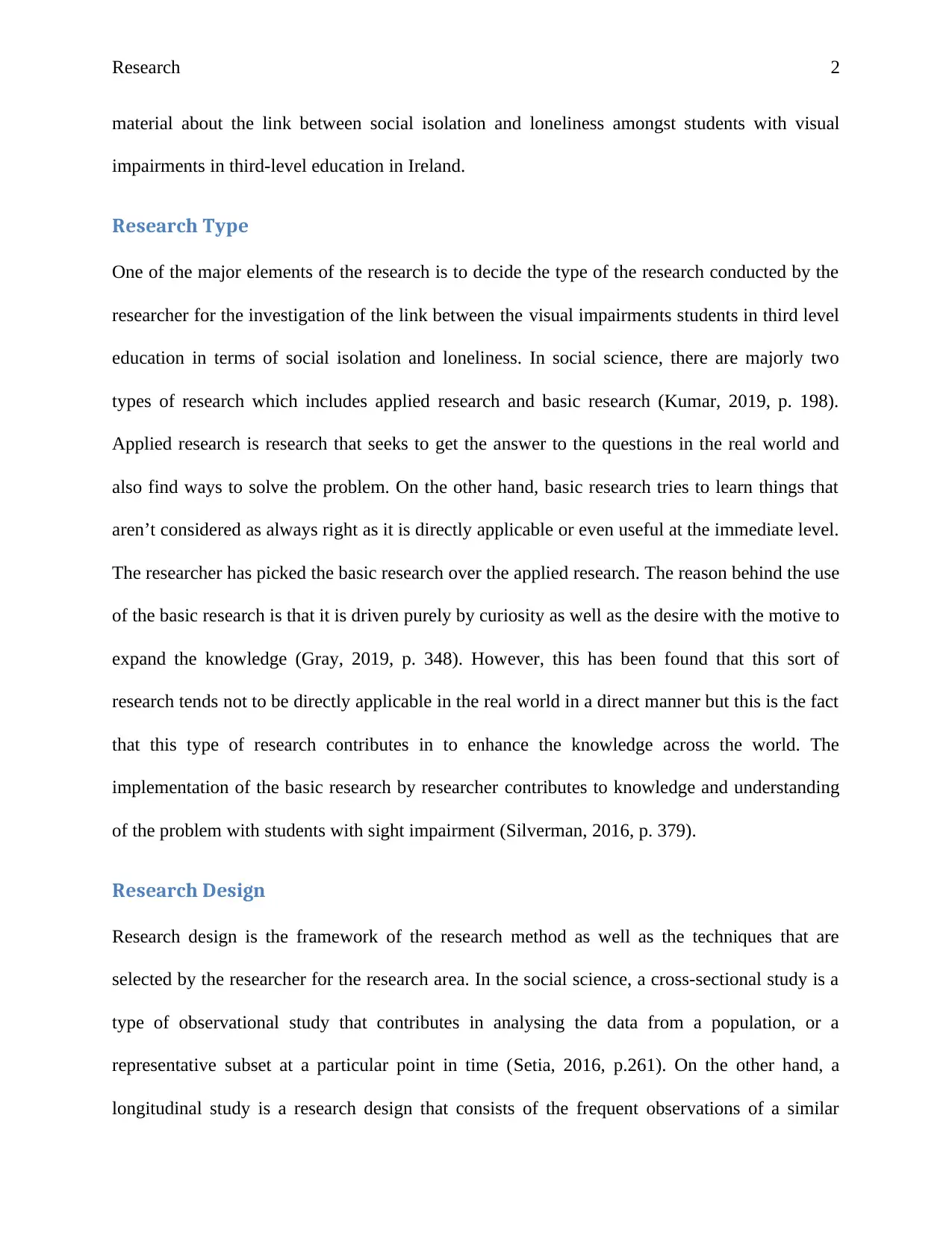
Research 2
material about the link between social isolation and loneliness amongst students with visual
impairments in third-level education in Ireland.
Research Type
One of the major elements of the research is to decide the type of the research conducted by the
researcher for the investigation of the link between the visual impairments students in third level
education in terms of social isolation and loneliness. In social science, there are majorly two
types of research which includes applied research and basic research (Kumar, 2019, p. 198).
Applied research is research that seeks to get the answer to the questions in the real world and
also find ways to solve the problem. On the other hand, basic research tries to learn things that
aren’t considered as always right as it is directly applicable or even useful at the immediate level.
The researcher has picked the basic research over the applied research. The reason behind the use
of the basic research is that it is driven purely by curiosity as well as the desire with the motive to
expand the knowledge (Gray, 2019, p. 348). However, this has been found that this sort of
research tends not to be directly applicable in the real world in a direct manner but this is the fact
that this type of research contributes in to enhance the knowledge across the world. The
implementation of the basic research by researcher contributes to knowledge and understanding
of the problem with students with sight impairment (Silverman, 2016, p. 379).
Research Design
Research design is the framework of the research method as well as the techniques that are
selected by the researcher for the research area. In the social science, a cross-sectional study is a
type of observational study that contributes in analysing the data from a population, or a
representative subset at a particular point in time (Setia, 2016, p.261). On the other hand, a
longitudinal study is a research design that consists of the frequent observations of a similar
material about the link between social isolation and loneliness amongst students with visual
impairments in third-level education in Ireland.
Research Type
One of the major elements of the research is to decide the type of the research conducted by the
researcher for the investigation of the link between the visual impairments students in third level
education in terms of social isolation and loneliness. In social science, there are majorly two
types of research which includes applied research and basic research (Kumar, 2019, p. 198).
Applied research is research that seeks to get the answer to the questions in the real world and
also find ways to solve the problem. On the other hand, basic research tries to learn things that
aren’t considered as always right as it is directly applicable or even useful at the immediate level.
The researcher has picked the basic research over the applied research. The reason behind the use
of the basic research is that it is driven purely by curiosity as well as the desire with the motive to
expand the knowledge (Gray, 2019, p. 348). However, this has been found that this sort of
research tends not to be directly applicable in the real world in a direct manner but this is the fact
that this type of research contributes in to enhance the knowledge across the world. The
implementation of the basic research by researcher contributes to knowledge and understanding
of the problem with students with sight impairment (Silverman, 2016, p. 379).
Research Design
Research design is the framework of the research method as well as the techniques that are
selected by the researcher for the research area. In the social science, a cross-sectional study is a
type of observational study that contributes in analysing the data from a population, or a
representative subset at a particular point in time (Setia, 2016, p.261). On the other hand, a
longitudinal study is a research design that consists of the frequent observations of a similar
⊘ This is a preview!⊘
Do you want full access?
Subscribe today to unlock all pages.

Trusted by 1+ million students worldwide
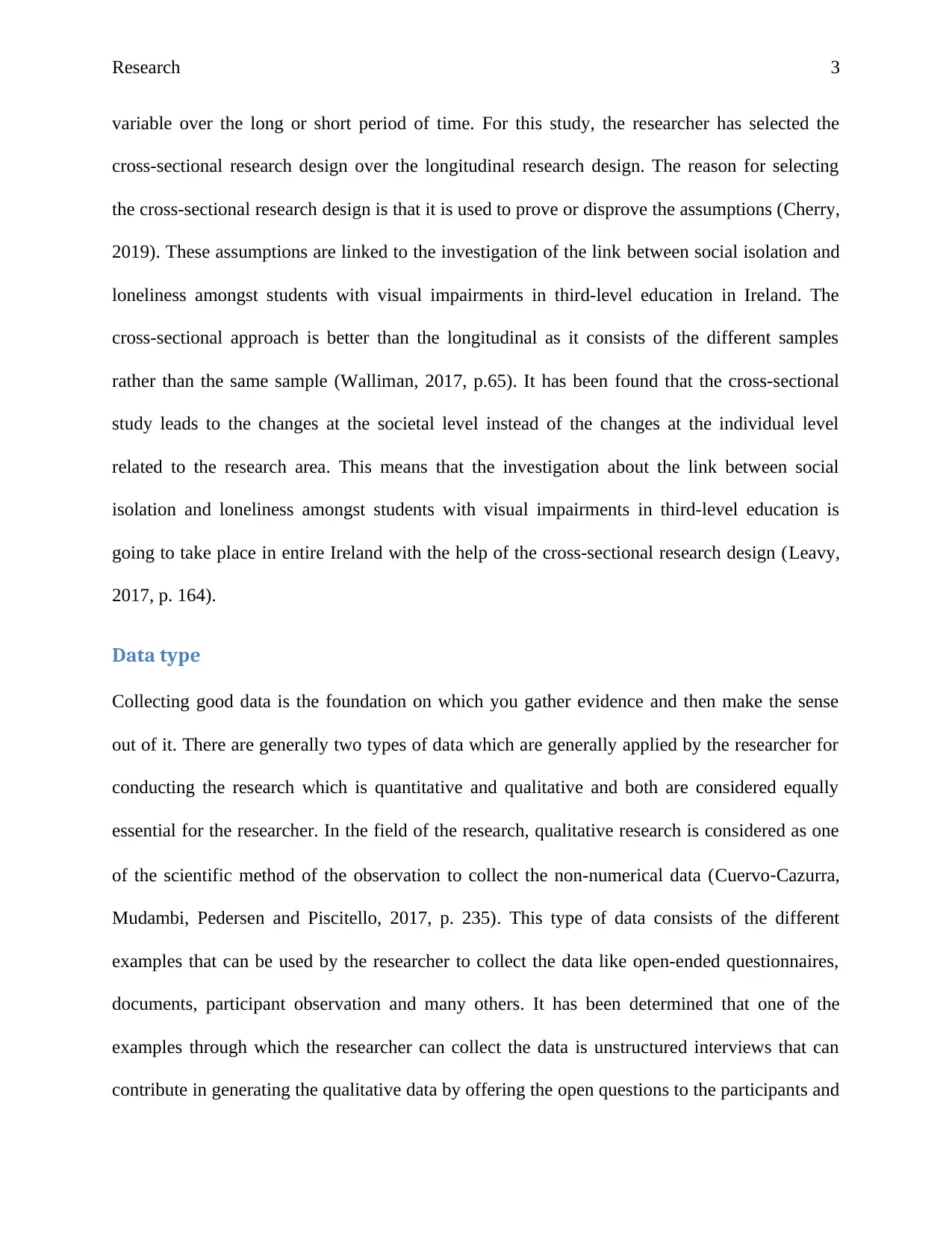
Research 3
variable over the long or short period of time. For this study, the researcher has selected the
cross-sectional research design over the longitudinal research design. The reason for selecting
the cross-sectional research design is that it is used to prove or disprove the assumptions (Cherry,
2019). These assumptions are linked to the investigation of the link between social isolation and
loneliness amongst students with visual impairments in third-level education in Ireland. The
cross-sectional approach is better than the longitudinal as it consists of the different samples
rather than the same sample (Walliman, 2017, p.65). It has been found that the cross-sectional
study leads to the changes at the societal level instead of the changes at the individual level
related to the research area. This means that the investigation about the link between social
isolation and loneliness amongst students with visual impairments in third-level education is
going to take place in entire Ireland with the help of the cross-sectional research design (Leavy,
2017, p. 164).
Data type
Collecting good data is the foundation on which you gather evidence and then make the sense
out of it. There are generally two types of data which are generally applied by the researcher for
conducting the research which is quantitative and qualitative and both are considered equally
essential for the researcher. In the field of the research, qualitative research is considered as one
of the scientific method of the observation to collect the non-numerical data (Cuervo‐Cazurra,
Mudambi, Pedersen and Piscitello, 2017, p. 235). This type of data consists of the different
examples that can be used by the researcher to collect the data like open-ended questionnaires,
documents, participant observation and many others. It has been determined that one of the
examples through which the researcher can collect the data is unstructured interviews that can
contribute in generating the qualitative data by offering the open questions to the participants and
variable over the long or short period of time. For this study, the researcher has selected the
cross-sectional research design over the longitudinal research design. The reason for selecting
the cross-sectional research design is that it is used to prove or disprove the assumptions (Cherry,
2019). These assumptions are linked to the investigation of the link between social isolation and
loneliness amongst students with visual impairments in third-level education in Ireland. The
cross-sectional approach is better than the longitudinal as it consists of the different samples
rather than the same sample (Walliman, 2017, p.65). It has been found that the cross-sectional
study leads to the changes at the societal level instead of the changes at the individual level
related to the research area. This means that the investigation about the link between social
isolation and loneliness amongst students with visual impairments in third-level education is
going to take place in entire Ireland with the help of the cross-sectional research design (Leavy,
2017, p. 164).
Data type
Collecting good data is the foundation on which you gather evidence and then make the sense
out of it. There are generally two types of data which are generally applied by the researcher for
conducting the research which is quantitative and qualitative and both are considered equally
essential for the researcher. In the field of the research, qualitative research is considered as one
of the scientific method of the observation to collect the non-numerical data (Cuervo‐Cazurra,
Mudambi, Pedersen and Piscitello, 2017, p. 235). This type of data consists of the different
examples that can be used by the researcher to collect the data like open-ended questionnaires,
documents, participant observation and many others. It has been determined that one of the
examples through which the researcher can collect the data is unstructured interviews that can
contribute in generating the qualitative data by offering the open questions to the participants and
Paraphrase This Document
Need a fresh take? Get an instant paraphrase of this document with our AI Paraphraser
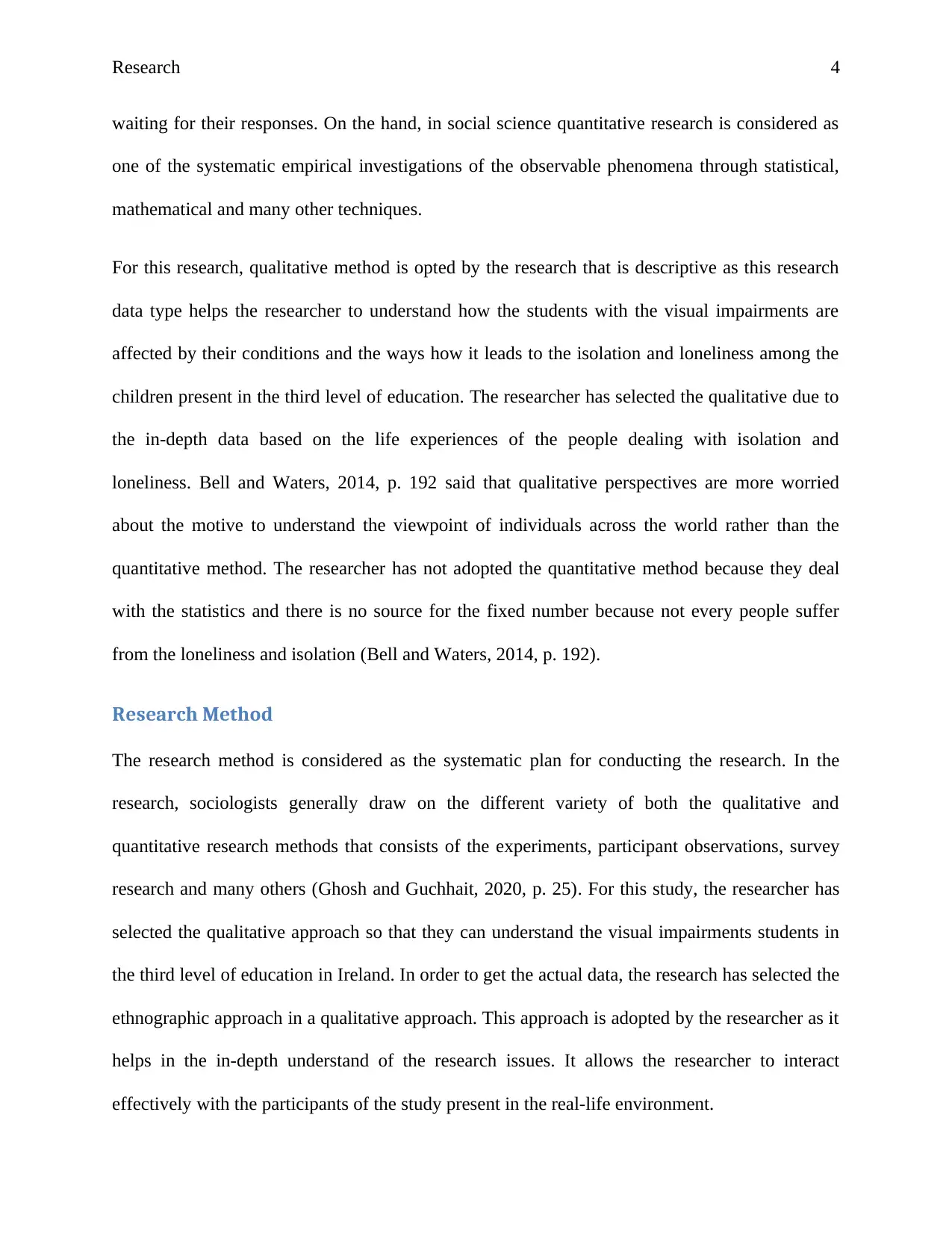
Research 4
waiting for their responses. On the hand, in social science quantitative research is considered as
one of the systematic empirical investigations of the observable phenomena through statistical,
mathematical and many other techniques.
For this research, qualitative method is opted by the research that is descriptive as this research
data type helps the researcher to understand how the students with the visual impairments are
affected by their conditions and the ways how it leads to the isolation and loneliness among the
children present in the third level of education. The researcher has selected the qualitative due to
the in-depth data based on the life experiences of the people dealing with isolation and
loneliness. Bell and Waters, 2014, p. 192 said that qualitative perspectives are more worried
about the motive to understand the viewpoint of individuals across the world rather than the
quantitative method. The researcher has not adopted the quantitative method because they deal
with the statistics and there is no source for the fixed number because not every people suffer
from the loneliness and isolation (Bell and Waters, 2014, p. 192).
Research Method
The research method is considered as the systematic plan for conducting the research. In the
research, sociologists generally draw on the different variety of both the qualitative and
quantitative research methods that consists of the experiments, participant observations, survey
research and many others (Ghosh and Guchhait, 2020, p. 25). For this study, the researcher has
selected the qualitative approach so that they can understand the visual impairments students in
the third level of education in Ireland. In order to get the actual data, the research has selected the
ethnographic approach in a qualitative approach. This approach is adopted by the researcher as it
helps in the in-depth understand of the research issues. It allows the researcher to interact
effectively with the participants of the study present in the real-life environment.
waiting for their responses. On the hand, in social science quantitative research is considered as
one of the systematic empirical investigations of the observable phenomena through statistical,
mathematical and many other techniques.
For this research, qualitative method is opted by the research that is descriptive as this research
data type helps the researcher to understand how the students with the visual impairments are
affected by their conditions and the ways how it leads to the isolation and loneliness among the
children present in the third level of education. The researcher has selected the qualitative due to
the in-depth data based on the life experiences of the people dealing with isolation and
loneliness. Bell and Waters, 2014, p. 192 said that qualitative perspectives are more worried
about the motive to understand the viewpoint of individuals across the world rather than the
quantitative method. The researcher has not adopted the quantitative method because they deal
with the statistics and there is no source for the fixed number because not every people suffer
from the loneliness and isolation (Bell and Waters, 2014, p. 192).
Research Method
The research method is considered as the systematic plan for conducting the research. In the
research, sociologists generally draw on the different variety of both the qualitative and
quantitative research methods that consists of the experiments, participant observations, survey
research and many others (Ghosh and Guchhait, 2020, p. 25). For this study, the researcher has
selected the qualitative approach so that they can understand the visual impairments students in
the third level of education in Ireland. In order to get the actual data, the research has selected the
ethnographic approach in a qualitative approach. This approach is adopted by the researcher as it
helps in the in-depth understand of the research issues. It allows the researcher to interact
effectively with the participants of the study present in the real-life environment.
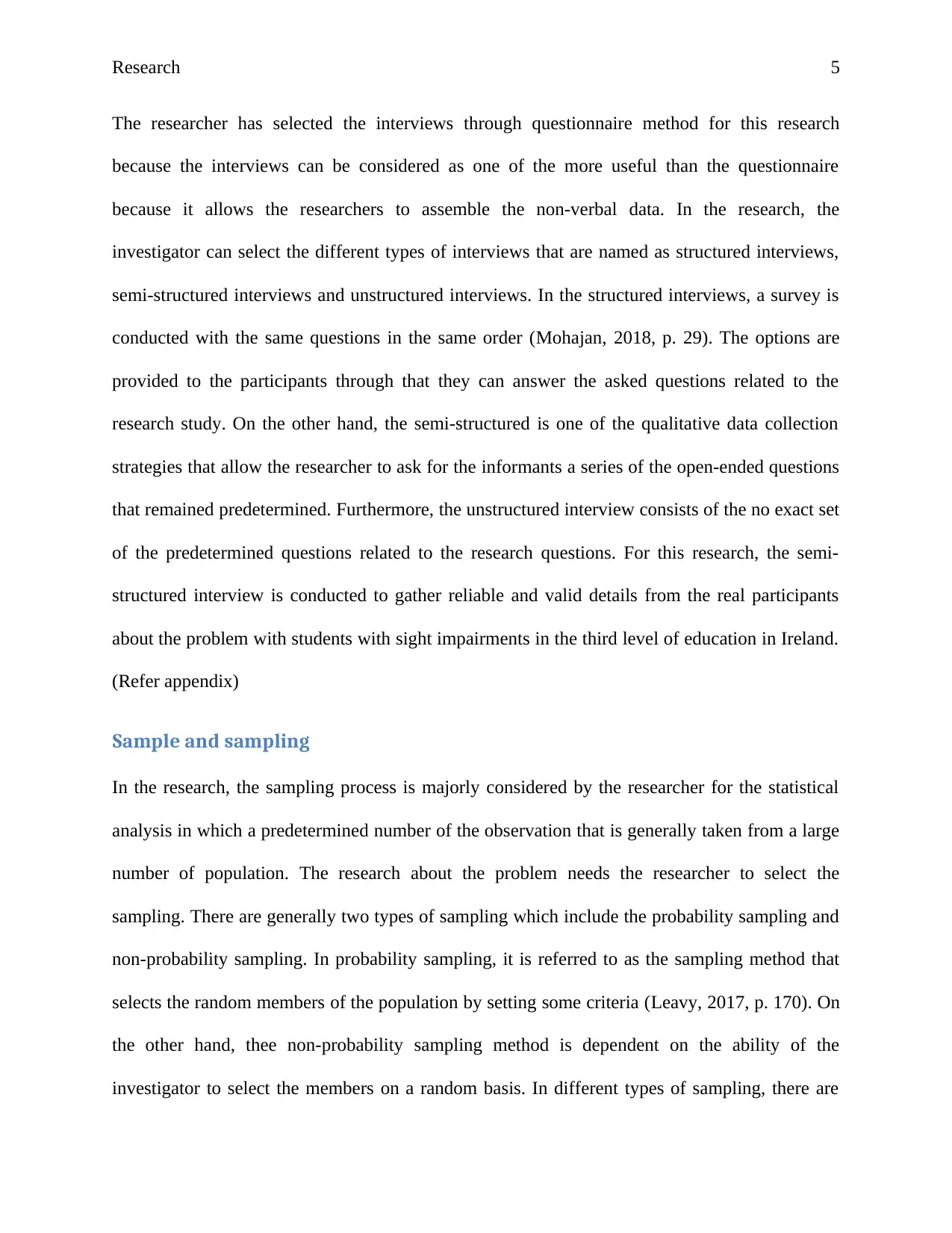
Research 5
The researcher has selected the interviews through questionnaire method for this research
because the interviews can be considered as one of the more useful than the questionnaire
because it allows the researchers to assemble the non-verbal data. In the research, the
investigator can select the different types of interviews that are named as structured interviews,
semi-structured interviews and unstructured interviews. In the structured interviews, a survey is
conducted with the same questions in the same order (Mohajan, 2018, p. 29). The options are
provided to the participants through that they can answer the asked questions related to the
research study. On the other hand, the semi-structured is one of the qualitative data collection
strategies that allow the researcher to ask for the informants a series of the open-ended questions
that remained predetermined. Furthermore, the unstructured interview consists of the no exact set
of the predetermined questions related to the research questions. For this research, the semi-
structured interview is conducted to gather reliable and valid details from the real participants
about the problem with students with sight impairments in the third level of education in Ireland.
(Refer appendix)
Sample and sampling
In the research, the sampling process is majorly considered by the researcher for the statistical
analysis in which a predetermined number of the observation that is generally taken from a large
number of population. The research about the problem needs the researcher to select the
sampling. There are generally two types of sampling which include the probability sampling and
non-probability sampling. In probability sampling, it is referred to as the sampling method that
selects the random members of the population by setting some criteria (Leavy, 2017, p. 170). On
the other hand, thee non-probability sampling method is dependent on the ability of the
investigator to select the members on a random basis. In different types of sampling, there are
The researcher has selected the interviews through questionnaire method for this research
because the interviews can be considered as one of the more useful than the questionnaire
because it allows the researchers to assemble the non-verbal data. In the research, the
investigator can select the different types of interviews that are named as structured interviews,
semi-structured interviews and unstructured interviews. In the structured interviews, a survey is
conducted with the same questions in the same order (Mohajan, 2018, p. 29). The options are
provided to the participants through that they can answer the asked questions related to the
research study. On the other hand, the semi-structured is one of the qualitative data collection
strategies that allow the researcher to ask for the informants a series of the open-ended questions
that remained predetermined. Furthermore, the unstructured interview consists of the no exact set
of the predetermined questions related to the research questions. For this research, the semi-
structured interview is conducted to gather reliable and valid details from the real participants
about the problem with students with sight impairments in the third level of education in Ireland.
(Refer appendix)
Sample and sampling
In the research, the sampling process is majorly considered by the researcher for the statistical
analysis in which a predetermined number of the observation that is generally taken from a large
number of population. The research about the problem needs the researcher to select the
sampling. There are generally two types of sampling which include the probability sampling and
non-probability sampling. In probability sampling, it is referred to as the sampling method that
selects the random members of the population by setting some criteria (Leavy, 2017, p. 170). On
the other hand, thee non-probability sampling method is dependent on the ability of the
investigator to select the members on a random basis. In different types of sampling, there are
⊘ This is a preview!⊘
Do you want full access?
Subscribe today to unlock all pages.

Trusted by 1+ million students worldwide
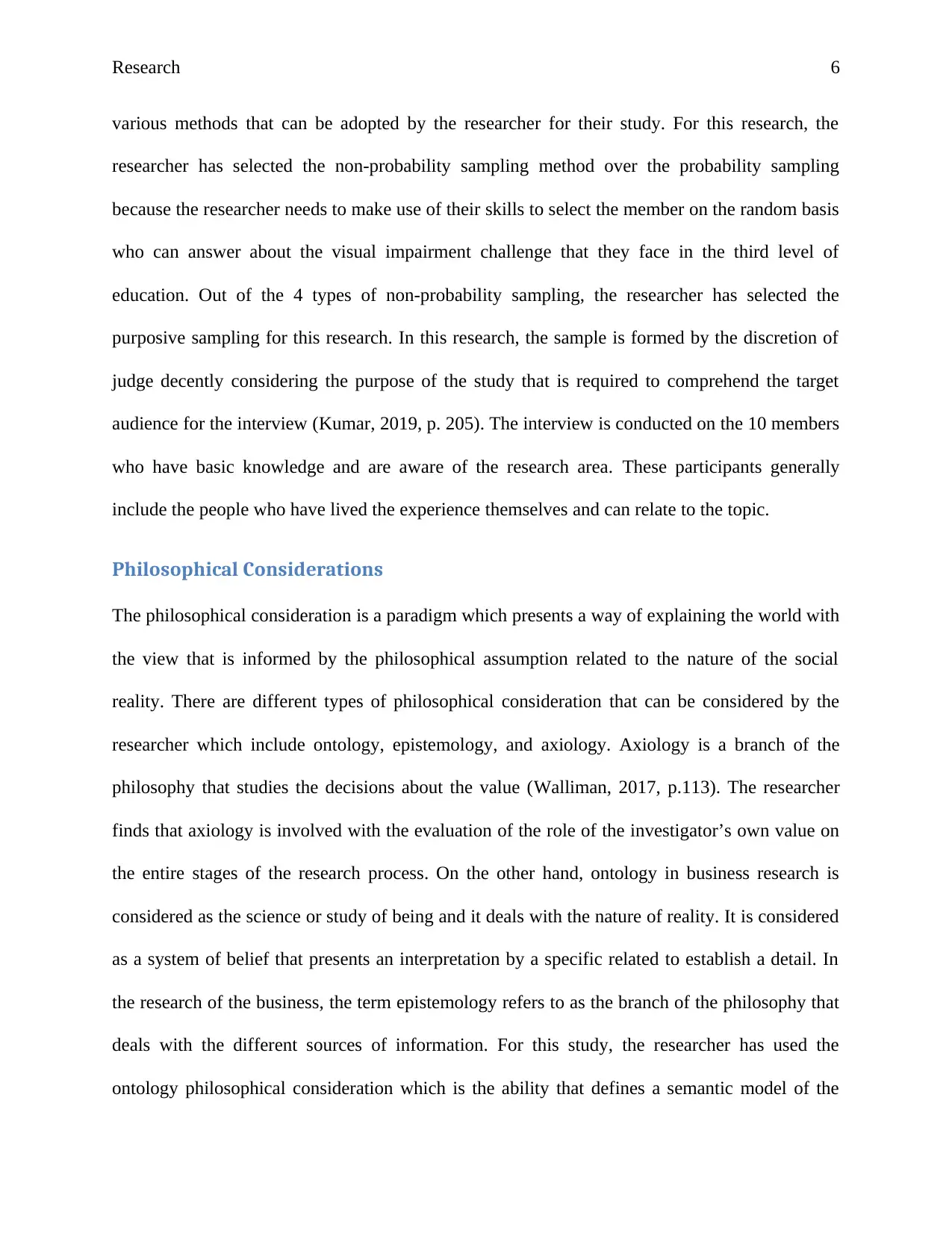
Research 6
various methods that can be adopted by the researcher for their study. For this research, the
researcher has selected the non-probability sampling method over the probability sampling
because the researcher needs to make use of their skills to select the member on the random basis
who can answer about the visual impairment challenge that they face in the third level of
education. Out of the 4 types of non-probability sampling, the researcher has selected the
purposive sampling for this research. In this research, the sample is formed by the discretion of
judge decently considering the purpose of the study that is required to comprehend the target
audience for the interview (Kumar, 2019, p. 205). The interview is conducted on the 10 members
who have basic knowledge and are aware of the research area. These participants generally
include the people who have lived the experience themselves and can relate to the topic.
Philosophical Considerations
The philosophical consideration is a paradigm which presents a way of explaining the world with
the view that is informed by the philosophical assumption related to the nature of the social
reality. There are different types of philosophical consideration that can be considered by the
researcher which include ontology, epistemology, and axiology. Axiology is a branch of the
philosophy that studies the decisions about the value (Walliman, 2017, p.113). The researcher
finds that axiology is involved with the evaluation of the role of the investigator’s own value on
the entire stages of the research process. On the other hand, ontology in business research is
considered as the science or study of being and it deals with the nature of reality. It is considered
as a system of belief that presents an interpretation by a specific related to establish a detail. In
the research of the business, the term epistemology refers to as the branch of the philosophy that
deals with the different sources of information. For this study, the researcher has used the
ontology philosophical consideration which is the ability that defines a semantic model of the
various methods that can be adopted by the researcher for their study. For this research, the
researcher has selected the non-probability sampling method over the probability sampling
because the researcher needs to make use of their skills to select the member on the random basis
who can answer about the visual impairment challenge that they face in the third level of
education. Out of the 4 types of non-probability sampling, the researcher has selected the
purposive sampling for this research. In this research, the sample is formed by the discretion of
judge decently considering the purpose of the study that is required to comprehend the target
audience for the interview (Kumar, 2019, p. 205). The interview is conducted on the 10 members
who have basic knowledge and are aware of the research area. These participants generally
include the people who have lived the experience themselves and can relate to the topic.
Philosophical Considerations
The philosophical consideration is a paradigm which presents a way of explaining the world with
the view that is informed by the philosophical assumption related to the nature of the social
reality. There are different types of philosophical consideration that can be considered by the
researcher which include ontology, epistemology, and axiology. Axiology is a branch of the
philosophy that studies the decisions about the value (Walliman, 2017, p.113). The researcher
finds that axiology is involved with the evaluation of the role of the investigator’s own value on
the entire stages of the research process. On the other hand, ontology in business research is
considered as the science or study of being and it deals with the nature of reality. It is considered
as a system of belief that presents an interpretation by a specific related to establish a detail. In
the research of the business, the term epistemology refers to as the branch of the philosophy that
deals with the different sources of information. For this study, the researcher has used the
ontology philosophical consideration which is the ability that defines a semantic model of the
Paraphrase This Document
Need a fresh take? Get an instant paraphrase of this document with our AI Paraphraser
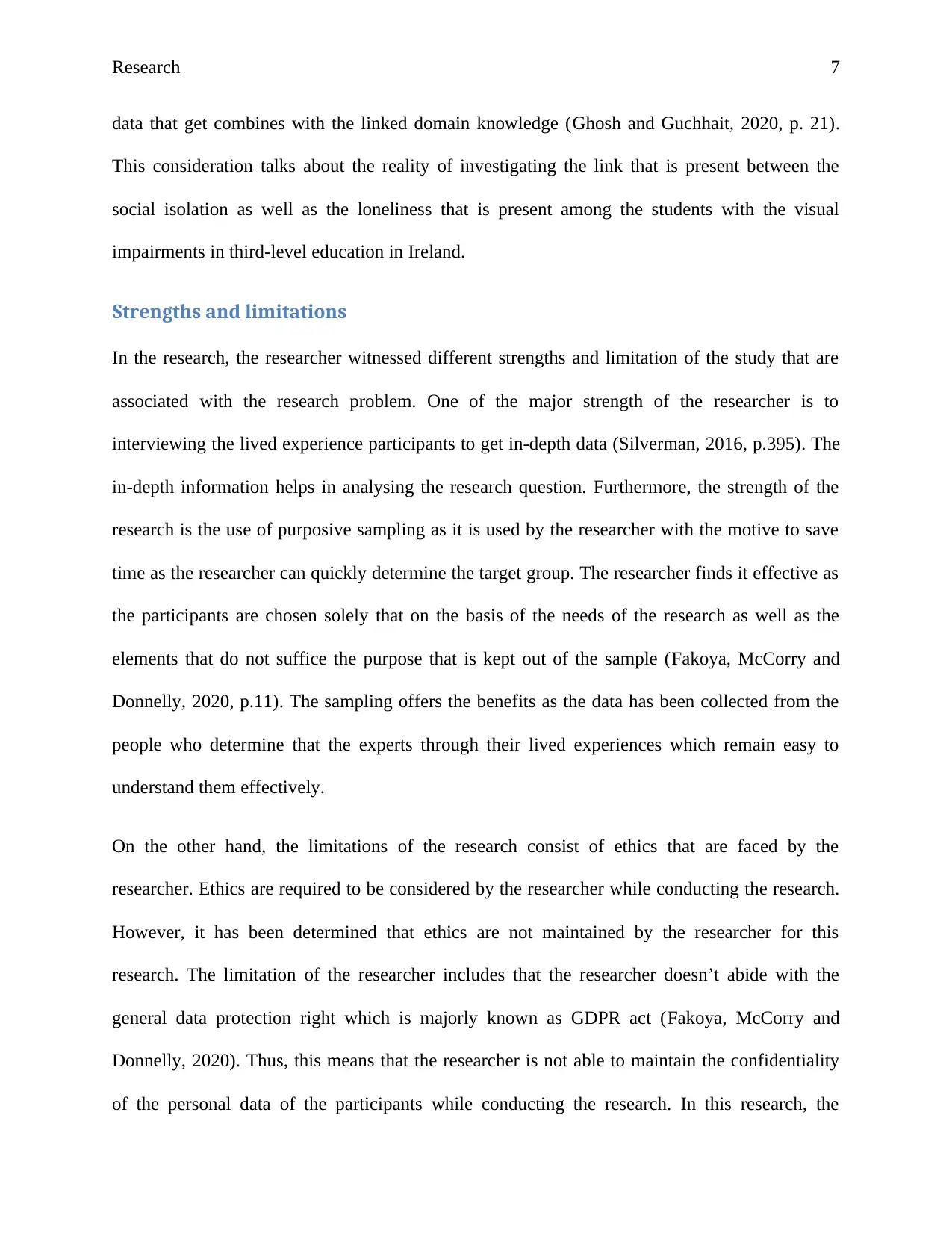
Research 7
data that get combines with the linked domain knowledge (Ghosh and Guchhait, 2020, p. 21).
This consideration talks about the reality of investigating the link that is present between the
social isolation as well as the loneliness that is present among the students with the visual
impairments in third-level education in Ireland.
Strengths and limitations
In the research, the researcher witnessed different strengths and limitation of the study that are
associated with the research problem. One of the major strength of the researcher is to
interviewing the lived experience participants to get in-depth data (Silverman, 2016, p.395). The
in-depth information helps in analysing the research question. Furthermore, the strength of the
research is the use of purposive sampling as it is used by the researcher with the motive to save
time as the researcher can quickly determine the target group. The researcher finds it effective as
the participants are chosen solely that on the basis of the needs of the research as well as the
elements that do not suffice the purpose that is kept out of the sample (Fakoya, McCorry and
Donnelly, 2020, p.11). The sampling offers the benefits as the data has been collected from the
people who determine that the experts through their lived experiences which remain easy to
understand them effectively.
On the other hand, the limitations of the research consist of ethics that are faced by the
researcher. Ethics are required to be considered by the researcher while conducting the research.
However, it has been determined that ethics are not maintained by the researcher for this
research. The limitation of the researcher includes that the researcher doesn’t abide with the
general data protection right which is majorly known as GDPR act (Fakoya, McCorry and
Donnelly, 2020). Thus, this means that the researcher is not able to maintain the confidentiality
of the personal data of the participants while conducting the research. In this research, the
data that get combines with the linked domain knowledge (Ghosh and Guchhait, 2020, p. 21).
This consideration talks about the reality of investigating the link that is present between the
social isolation as well as the loneliness that is present among the students with the visual
impairments in third-level education in Ireland.
Strengths and limitations
In the research, the researcher witnessed different strengths and limitation of the study that are
associated with the research problem. One of the major strength of the researcher is to
interviewing the lived experience participants to get in-depth data (Silverman, 2016, p.395). The
in-depth information helps in analysing the research question. Furthermore, the strength of the
research is the use of purposive sampling as it is used by the researcher with the motive to save
time as the researcher can quickly determine the target group. The researcher finds it effective as
the participants are chosen solely that on the basis of the needs of the research as well as the
elements that do not suffice the purpose that is kept out of the sample (Fakoya, McCorry and
Donnelly, 2020, p.11). The sampling offers the benefits as the data has been collected from the
people who determine that the experts through their lived experiences which remain easy to
understand them effectively.
On the other hand, the limitations of the research consist of ethics that are faced by the
researcher. Ethics are required to be considered by the researcher while conducting the research.
However, it has been determined that ethics are not maintained by the researcher for this
research. The limitation of the researcher includes that the researcher doesn’t abide with the
general data protection right which is majorly known as GDPR act (Fakoya, McCorry and
Donnelly, 2020). Thus, this means that the researcher is not able to maintain the confidentiality
of the personal data of the participants while conducting the research. In this research, the
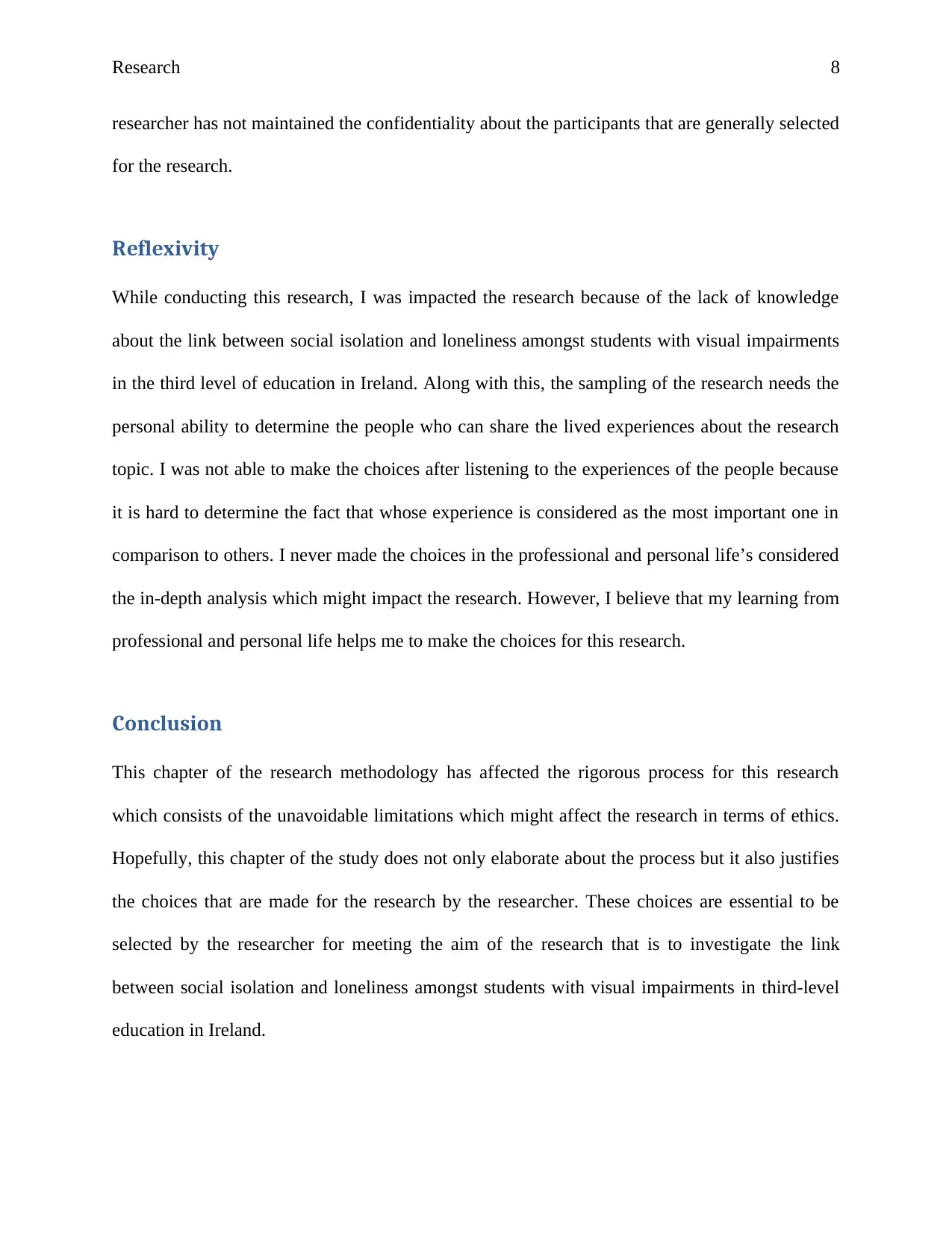
Research 8
researcher has not maintained the confidentiality about the participants that are generally selected
for the research.
Reflexivity
While conducting this research, I was impacted the research because of the lack of knowledge
about the link between social isolation and loneliness amongst students with visual impairments
in the third level of education in Ireland. Along with this, the sampling of the research needs the
personal ability to determine the people who can share the lived experiences about the research
topic. I was not able to make the choices after listening to the experiences of the people because
it is hard to determine the fact that whose experience is considered as the most important one in
comparison to others. I never made the choices in the professional and personal life’s considered
the in-depth analysis which might impact the research. However, I believe that my learning from
professional and personal life helps me to make the choices for this research.
Conclusion
This chapter of the research methodology has affected the rigorous process for this research
which consists of the unavoidable limitations which might affect the research in terms of ethics.
Hopefully, this chapter of the study does not only elaborate about the process but it also justifies
the choices that are made for the research by the researcher. These choices are essential to be
selected by the researcher for meeting the aim of the research that is to investigate the link
between social isolation and loneliness amongst students with visual impairments in third-level
education in Ireland.
researcher has not maintained the confidentiality about the participants that are generally selected
for the research.
Reflexivity
While conducting this research, I was impacted the research because of the lack of knowledge
about the link between social isolation and loneliness amongst students with visual impairments
in the third level of education in Ireland. Along with this, the sampling of the research needs the
personal ability to determine the people who can share the lived experiences about the research
topic. I was not able to make the choices after listening to the experiences of the people because
it is hard to determine the fact that whose experience is considered as the most important one in
comparison to others. I never made the choices in the professional and personal life’s considered
the in-depth analysis which might impact the research. However, I believe that my learning from
professional and personal life helps me to make the choices for this research.
Conclusion
This chapter of the research methodology has affected the rigorous process for this research
which consists of the unavoidable limitations which might affect the research in terms of ethics.
Hopefully, this chapter of the study does not only elaborate about the process but it also justifies
the choices that are made for the research by the researcher. These choices are essential to be
selected by the researcher for meeting the aim of the research that is to investigate the link
between social isolation and loneliness amongst students with visual impairments in third-level
education in Ireland.
⊘ This is a preview!⊘
Do you want full access?
Subscribe today to unlock all pages.

Trusted by 1+ million students worldwide
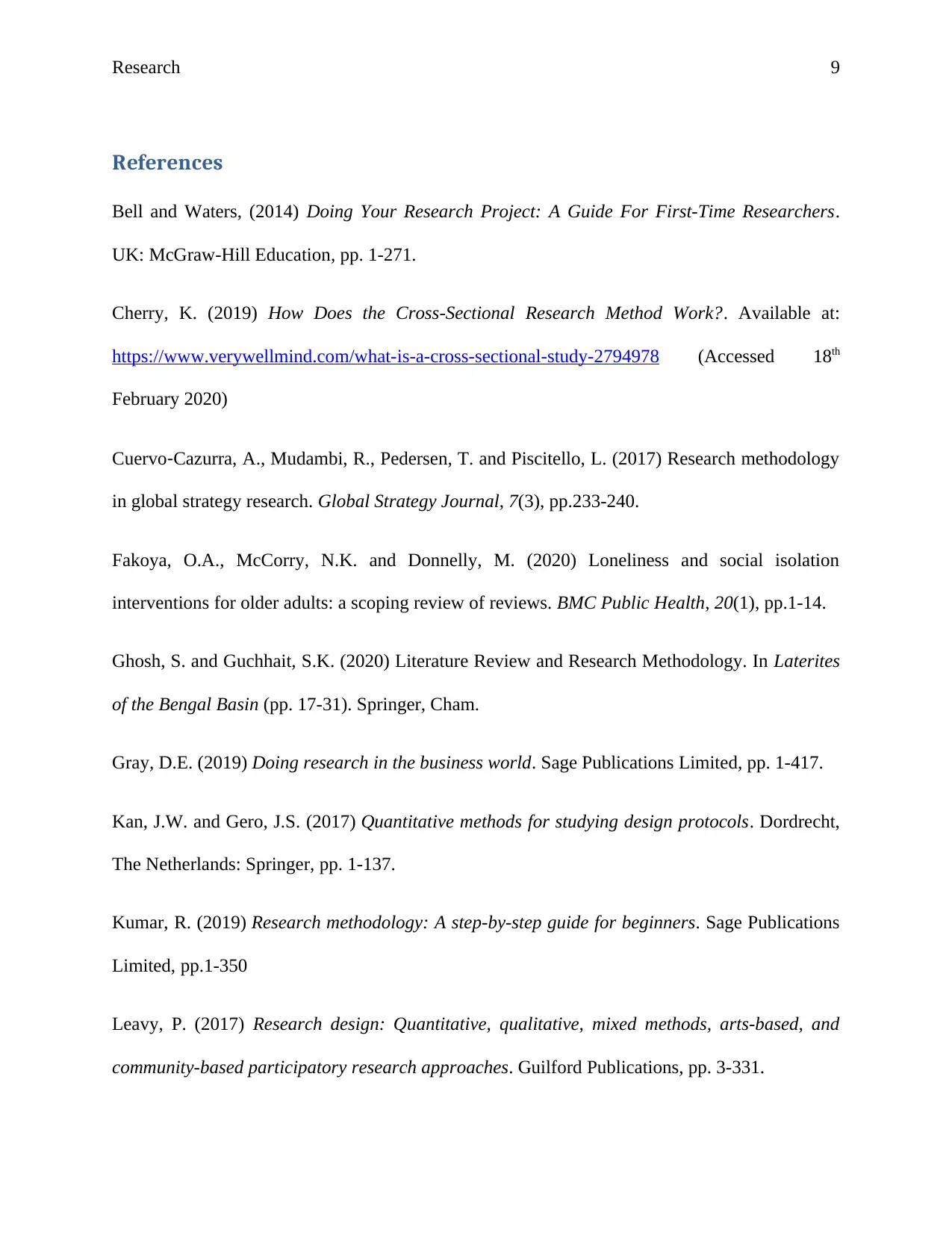
Research 9
References
Bell and Waters, (2014) Doing Your Research Project: A Guide For First-Time Researchers.
UK: McGraw-Hill Education, pp. 1-271.
Cherry, K. (2019) How Does the Cross-Sectional Research Method Work?. Available at:
https://www.verywellmind.com/what-is-a-cross-sectional-study-2794978 (Accessed 18th
February 2020)
Cuervo‐Cazurra, A., Mudambi, R., Pedersen, T. and Piscitello, L. (2017) Research methodology
in global strategy research. Global Strategy Journal, 7(3), pp.233-240.
Fakoya, O.A., McCorry, N.K. and Donnelly, M. (2020) Loneliness and social isolation
interventions for older adults: a scoping review of reviews. BMC Public Health, 20(1), pp.1-14.
Ghosh, S. and Guchhait, S.K. (2020) Literature Review and Research Methodology. In Laterites
of the Bengal Basin (pp. 17-31). Springer, Cham.
Gray, D.E. (2019) Doing research in the business world. Sage Publications Limited, pp. 1-417.
Kan, J.W. and Gero, J.S. (2017) Quantitative methods for studying design protocols. Dordrecht,
The Netherlands: Springer, pp. 1-137.
Kumar, R. (2019) Research methodology: A step-by-step guide for beginners. Sage Publications
Limited, pp.1-350
Leavy, P. (2017) Research design: Quantitative, qualitative, mixed methods, arts-based, and
community-based participatory research approaches. Guilford Publications, pp. 3-331.
References
Bell and Waters, (2014) Doing Your Research Project: A Guide For First-Time Researchers.
UK: McGraw-Hill Education, pp. 1-271.
Cherry, K. (2019) How Does the Cross-Sectional Research Method Work?. Available at:
https://www.verywellmind.com/what-is-a-cross-sectional-study-2794978 (Accessed 18th
February 2020)
Cuervo‐Cazurra, A., Mudambi, R., Pedersen, T. and Piscitello, L. (2017) Research methodology
in global strategy research. Global Strategy Journal, 7(3), pp.233-240.
Fakoya, O.A., McCorry, N.K. and Donnelly, M. (2020) Loneliness and social isolation
interventions for older adults: a scoping review of reviews. BMC Public Health, 20(1), pp.1-14.
Ghosh, S. and Guchhait, S.K. (2020) Literature Review and Research Methodology. In Laterites
of the Bengal Basin (pp. 17-31). Springer, Cham.
Gray, D.E. (2019) Doing research in the business world. Sage Publications Limited, pp. 1-417.
Kan, J.W. and Gero, J.S. (2017) Quantitative methods for studying design protocols. Dordrecht,
The Netherlands: Springer, pp. 1-137.
Kumar, R. (2019) Research methodology: A step-by-step guide for beginners. Sage Publications
Limited, pp.1-350
Leavy, P. (2017) Research design: Quantitative, qualitative, mixed methods, arts-based, and
community-based participatory research approaches. Guilford Publications, pp. 3-331.
Paraphrase This Document
Need a fresh take? Get an instant paraphrase of this document with our AI Paraphraser
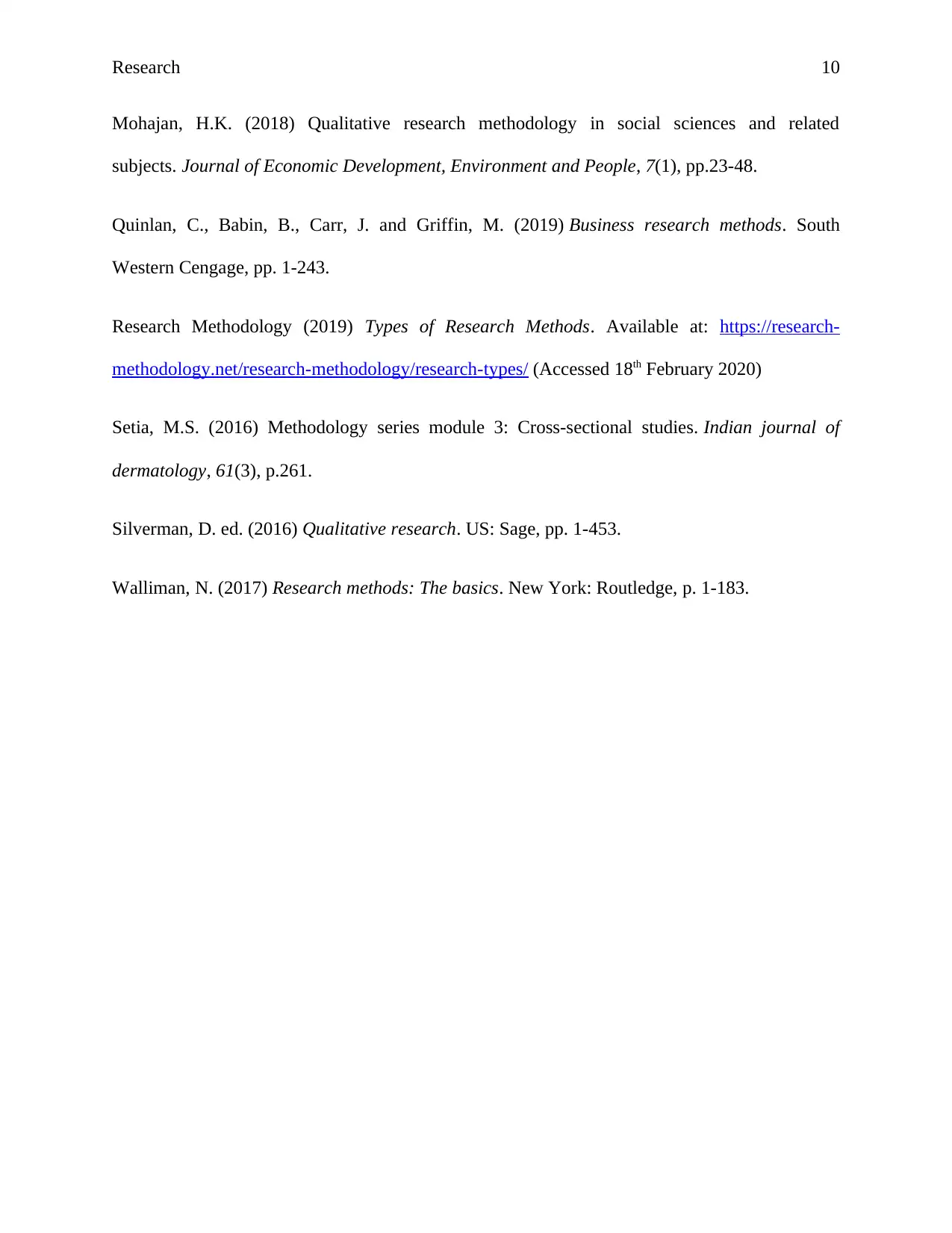
Research 10
Mohajan, H.K. (2018) Qualitative research methodology in social sciences and related
subjects. Journal of Economic Development, Environment and People, 7(1), pp.23-48.
Quinlan, C., Babin, B., Carr, J. and Griffin, M. (2019) Business research methods. South
Western Cengage, pp. 1-243.
Research Methodology (2019) Types of Research Methods. Available at: https://research-
methodology.net/research-methodology/research-types/ (Accessed 18th February 2020)
Setia, M.S. (2016) Methodology series module 3: Cross-sectional studies. Indian journal of
dermatology, 61(3), p.261.
Silverman, D. ed. (2016) Qualitative research. US: Sage, pp. 1-453.
Walliman, N. (2017) Research methods: The basics. New York: Routledge, p. 1-183.
Mohajan, H.K. (2018) Qualitative research methodology in social sciences and related
subjects. Journal of Economic Development, Environment and People, 7(1), pp.23-48.
Quinlan, C., Babin, B., Carr, J. and Griffin, M. (2019) Business research methods. South
Western Cengage, pp. 1-243.
Research Methodology (2019) Types of Research Methods. Available at: https://research-
methodology.net/research-methodology/research-types/ (Accessed 18th February 2020)
Setia, M.S. (2016) Methodology series module 3: Cross-sectional studies. Indian journal of
dermatology, 61(3), p.261.
Silverman, D. ed. (2016) Qualitative research. US: Sage, pp. 1-453.
Walliman, N. (2017) Research methods: The basics. New York: Routledge, p. 1-183.

Research 11
Appendix
Interview questions
Q1. Please specify your age group and gender?
Q2. Please specify your profession and type of work in which you are involved?
Q3. Have you ever faced the issue of social isolation and loneliness at the time of third level
education?
Q4. How social isolation and loneliness affected your personal and professional life?
Q5. What are your views about the link between the social isolation and loneliness amongst
students with visual impairments in third level education in Ireland?
Q6. Would you like to share your experience about the concern topic?
Q7. To what extent the social isolation and loneliness affects the lives of the people with the
visual impairments at third level of education?
Q8. What are the factors that contribute in causing the social isolation and loneliness in adults
who are dealing with the visual impairments?
Q9. How you would have tried to come out of the social isolation and loneliness in adults who
are dealing with the visual impairments?
Q10. Would you like to give some suggestion about the ways to bring the decline the issues for
the visual impairments in third level education in Ireland?
Appendix
Interview questions
Q1. Please specify your age group and gender?
Q2. Please specify your profession and type of work in which you are involved?
Q3. Have you ever faced the issue of social isolation and loneliness at the time of third level
education?
Q4. How social isolation and loneliness affected your personal and professional life?
Q5. What are your views about the link between the social isolation and loneliness amongst
students with visual impairments in third level education in Ireland?
Q6. Would you like to share your experience about the concern topic?
Q7. To what extent the social isolation and loneliness affects the lives of the people with the
visual impairments at third level of education?
Q8. What are the factors that contribute in causing the social isolation and loneliness in adults
who are dealing with the visual impairments?
Q9. How you would have tried to come out of the social isolation and loneliness in adults who
are dealing with the visual impairments?
Q10. Would you like to give some suggestion about the ways to bring the decline the issues for
the visual impairments in third level education in Ireland?
⊘ This is a preview!⊘
Do you want full access?
Subscribe today to unlock all pages.

Trusted by 1+ million students worldwide
1 out of 13
Related Documents
Your All-in-One AI-Powered Toolkit for Academic Success.
+13062052269
info@desklib.com
Available 24*7 on WhatsApp / Email
![[object Object]](/_next/static/media/star-bottom.7253800d.svg)
Unlock your academic potential
Copyright © 2020–2025 A2Z Services. All Rights Reserved. Developed and managed by ZUCOL.





